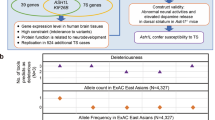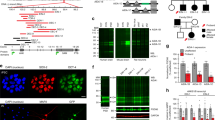Abstract
The identification of novel genes underlying complex mouse behavioral traits remains an important step in understanding normal brain function and its dysfunction in mental health disorders. To identify dominant mutations that influence locomotor activity, we performed a mouse N-ethyl-N-nitrosourea (ENU) forward mutagenesis screen and mapped several loci as quantitative traits. Here we describe the fine-mapping and positional cloning of a hyperactivity locus mapped to the medial portion of mouse chromosome four. We employed a modified recombinant progeny testing approach to fine-map the confidence interval from ≈20 Mb down to ≈5 Mb. Whole exome resequencing of all exons in this region revealed a single missense mutation in the adhesion G protein-coupled receptor brain-specific angiogenesis inhibitor 2 (Bai2). This mutation, R619W, is located in a critical extracellular domain that is a hotspot for mutations in this receptor class. We find that in two different mammalian cell lines, surface expression of Bai2 R619W is markedly reduced relative to wild-type Bai2, suggesting that R619W is a loss-of-function mutation. Our results highlight the powerful combination of ENU mutagenesis and next-generation sequencing to identify specific mutations that manifest as subtle behavioral phenotypes.





Similar content being viewed by others
References
Andrews TD et al (2012) Massively parallel sequencing of the mouse exome to accurately identify rare, induced mutations: an immediate source for thousands of new mouse models. Open Biol 2:120061. doi:10.1098/rsob.120061
Arac D, Boucard AA, Bolliger MF, Nguyen J, Soltis SM, Sudhof TC, Brunger AT (2012) A novel evolutionarily conserved domain of cell-adhesion GPCRs mediates autoproteolysis. EMBO J 31:1364–1378. doi:10.1038/emboj.2012.26
Bolliger MF, Martinelli DC, Sudhof TC (2011) The cell-adhesion G protein-coupled receptor BAI3 is a high-affinity receptor for C1q-like proteins. Proc Natl Acad Sci USA 108:2534–2539. doi:10.1073/pnas.1019577108
DuBridge RB, Tang P, Hsia HC, Leong PM, Miller JH, Calos MP (1987) Analysis of mutation in human cells by using an Epstein-Barr virus shuttle system. Mol Cell Biol 7:379–387
Duman JG, Tzeng CP, Tu YK, Munjal T, Schwechter B, Ho TS, Tolias KF (2013) The adhesion-GPCR BAI1 regulates synaptogenesis by controlling the recruitment of the Par3/Tiam1 polarity complex to synaptic sites. J Neurosci 33:6964–6978. doi:10.1523/JNEUROSCI.3978-12.2013
Fehr C, Shirley RL, Belknap JK, Crabbe JC, Buck KJ (2002) Congenic mapping of alcohol and pentobarbital withdrawal liability loci to a < 1 centimorgan interval of murine chromosome 4: identification of Mpdz as a candidate gene. J Neurosci 22:3730–3738
Funato H et al (2016) Forward-genetics analysis of sleep in randomly mutagenized mice. Nature 539:378–383. doi:10.1038/nature20142
Gallego-Llamas J, Timms AE, Geister KA, Lindsay A, Beier DR (2015) Variant mapping and mutation discovery in inbred mice using next-generation sequencing. BMC Genomics 16:913. doi:10.1186/s12864-015-2173-1
Giros B, Jaber M, Jones SR, Wightman RM, Caron MG (1996) Hyperlocomotion and indifference to cocaine and amphetamine in mice lacking the dopamine transporter. Nature 379:606–612. doi:10.1038/379606a0
Ha S, Stottmann RW, Furley AJ, Beier DR (2015) A forward genetic screen in mice identifies mutants with abnormal cortical patterning. Cereb Cortex 25:167–179. doi:10.1093/cercor/bht209
Hossain MS et al (2016) Identification of mutations through dominant screening for obesity using C57BL/6 substrains. Sci Rep 6:32453. doi:10.1038/srep32453
IMPC Adgrb2 locomotor behavior URL. https://www.mousephenotype.org/phenoview/?gid=5997&qeid=IMPC_OFD_005_001,IMPC_OFD_007_001,IMPC_OFD_009_001,IMPC_OFD_010_001,IMPC_OFD_020_001
Jin Z, Tietjen I, Bu L, Liu-Yesucevitz L, Gaur SK, Walsh CA, Piao X (2007) Disease-associated mutations affect GPR56 protein trafficking and cell surface expression. Hum Mol Genet 16:1972–1985. doi:10.1093/hmg/ddm144
Kakegawa W et al (2015) Anterograde C1ql1 signaling is required in order to determine and maintain a single-winner climbing fiber in the mouse cerebellum. Neuron 85:316–329. doi:10.1016/j.neuron.2014.12.020
Kan Z et al (2010) Diverse somatic mutation patterns and pathway alterations in human cancers. Nature 466:869–873. doi:10.1038/nature09208
Kee HJ et al (2002) Expression of brain-specific angiogenesis inhibitor 2 (BAI2) in normal and ischemic brain: involvement of BAI2 in the ischemia-induced brain angiogenesis. J Cereb Blood Flow Metab 22:1054–1067. doi:10.1097/00004647-200209000-00003
Kumar V, Kim K, Joseph C, Thomas LC, Hong H, Takahashi JS (2011) Second-generation high-throughput forward genetic screen in mice to isolate subtle behavioral mutants. Proc Natl Acad Sci USA 108(Suppl 3):15557–15564. doi:10.1073/pnas.1107726108
Langenhan T, Aust G, Hamann J (2013) Sticky signaling—adhesion class G protein-coupled receptors take the stage. Sci Signal 6:re3. doi:10.1126/scisignal.2003825
Langenhan T, Piao X, Monk KR (2016) Adhesion G protein-coupled receptors in nervous system development and disease. Nat Rev Neurosci 17:550–561. doi:10.1038/nrn.2016.86
McKenna A et al (2010) The Genome Analysis Toolkit: a MapReduce framework for analyzing next-generation DNA sequencing data. Genome Res 20:1297–1303. doi:10.1101/gr.107524.110
Militi S et al (2016) Early doors (Edo) mutant mouse reveals the importance of period 2 (PER2) PAS domain structure for circadian pacemaking. Proc Natl Acad Sci USA 113:2756–2761. doi:10.1073/pnas.1517549113
Okajima D, Kudo G, Yokota H (2011) Antidepressant-like behavior in brain-specific angiogenesis inhibitor 2-deficient mice. J Physiol Sci 61:47–54. doi:10.1007/s12576-010-0120-0
Pang J, Zeng X, Xiao RP, Lakatta EG, Lin L (2009) Design, generation, and testing of mammalian expression modules that tag membrane proteins. Protein Sci 18:1261–1271. doi:10.1002/pro.136
Selimi F, Cristea IM, Heller E, Chait BT, Heintz N (2009) Proteomic studies of a single CNS synapse type: the parallel fiber/purkinje cell synapse. PLoS Biol 7:e83. doi:10.1371/journal.pbio.1000083
Shi G, Kleinklaus AK, Marrion NV, Trimmer JS (1994) Properties of Kv2.1 K+ channels expressed in transfected mammalian cells. J Biol Chem 269:23204–23211
Simon MM, Moresco EM, Bull KR, Kumar S, Mallon AM, Beutler B, Potter PK (2015) Current strategies for mutation detection in phenotype-driven screens utilising next generation sequencing. Mamm Genome 26:486–500. doi:10.1007/s00335-015-9603-x
Sittig LJ, Carbonetto P, Engel KA, Krauss KS, Barrios-Camacho CM, Palmer AA (2016) Genetic background limits generalizability of genotype-phenotype relationships. Neuron 91:1253–1259. doi:10.1016/j.neuron.2016.08.013
SnpEff: Genetic variant annotation and effect prediction toolbox. http://snpeff.sourceforge.net/
Speca DJ, Rabbee N, Chihara D, Speed TP, Peterson AS (2006) A genetic screen for behavioral mutations that perturb dopaminergic homeostasis in mice. Genes Brain Behav 5:19–28. doi:10.1111/j.1601-183X.2005.00127.x
Speca DJ et al (2010) Conserved role of unc-79 in ethanol responses in lightweight mutant mice. PLoS Genet. doi:10.1371/journal.pgen.1001057
Wakeland E, Morel L, Achey K, Yui M, Longmate J (1997) Speed congenics: a classic technique in the fast lane (relatively speaking). Immunol Today 18:472–477
Yalcin B et al (2004) Genetic dissection of a behavioral quantitative trait locus shows that Rgs2 modulates anxiety in mice. Nat Genet 36:1197–1202. doi:10.1038/ng1450
Acknowledgements
We thank Colleen Manning and Danielle Mandikian for helpful advice on cell culture experiments and microscopy. Whole exome sequencing was performed at the Broad Center as part of the Mutant Mouse Re-sequencing Project at the Broad Institute (NHGRI). This research was supported by the State of California for medical research on alcohol and substance abuse through the University of California at San Francisco as well as grants from the Department of Defense (DAMD17-01-1-0799, A.S.P.), the NIH (R03-MH108950) and an Innovative Development Award from the U.C. Davis Academic Federation (D.J.S), and a NIH New Director’s Innovator Award Program DP2 OD006479-01 (ED).
Author information
Authors and Affiliations
Corresponding author
Ethics declarations
Conflict of interest
The authors declare that no competing interests exist.
Electronic supplementary material
Below is the link to the electronic supplementary material.
Rights and permissions
About this article
Cite this article
Speca, D.J., Trimmer, J.S., Peterson, A.S. et al. Whole exome sequencing reveals a functional mutation in the GAIN domain of the Bai2 receptor underlying a forward mutagenesis hyperactivity QTL. Mamm Genome 28, 465–475 (2017). https://doi.org/10.1007/s00335-017-9716-5
Received:
Accepted:
Published:
Issue Date:
DOI: https://doi.org/10.1007/s00335-017-9716-5




